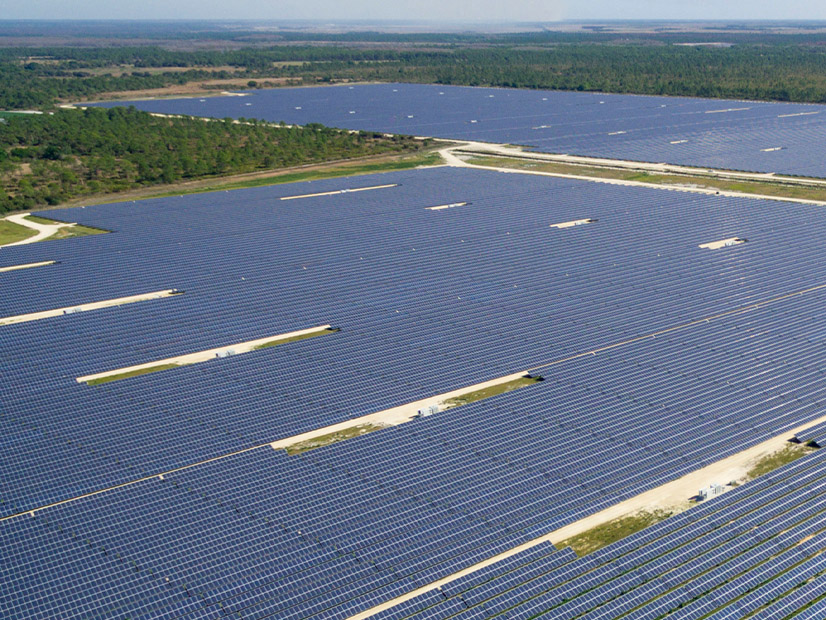
NERC is calling on owners of Bulk Electric System-connected solar generation assets to step up and take action aimed at preventing “systemic performance issues” that can cause disturbances to electric service.
The organization provided a series of recommendations for generator owners (GOs) of BES solar facilities in its latest Level 2 alert, released on Tuesday. NERC tied the alert to “multiple large-scale disturbances … involving widespread loss of inverter-based resources (IBRs).”
The document cited the disturbances that happened near Odessa, Texas, in 2021 and 2022. (See NERC Repeats IBR Warnings After Second Odessa Event.)
During the 2021 event, the Texas interconnection lost 1,340 MW of solar and synchronous generation near the town of Odessa; just over a year later, a similar incident caused the loss of 2,555 MW. In a December report, NERC and the Texas Reliability Entity noted the similarities between the two events — including the fact that many facilities involved in the 2021 disturbance responded abnormally in 2022 as well — and called for “immediate industry action” to ensure that IBRs do not pose a threat to grid reliability.
Echoing the December report, the alert said that “as the penetration of [grid]-connected IBRs continues to rapidly increase, it is paramount that any performance deficiencies with existing (and future) generation resources be addressed in an effective and efficient manner.”
Tuesday’s alert was distributed only to GOs of BES-connected solar resources — meaning those that are subject to NERC’s reliability standards — but the authors said owners of solar resources connected to the grid but not under the ERO’s jurisdiction should still review its recommendations and implement them where appropriate. They said the recommendations may also be applicable to grid-connected battery energy storage systems, though not to wind resources, which also use inverters, because “the observed performance issues are different.”
Utilities Urged to Coordinate with Manufacturers
The measures provided in the alert are not mandatory; instead, NERC “strongly encouraged” GOs to adopt them. However, recipients are required to acknowledge receipt of the alert by March 21 and respond to a series of questions about their BPS-connected solar facilities (if any) by June 30.
NERC’s first recommendation is that GOs coordinate with manufacturers of inverters on their systems on inverter-protection settings. These should be set according to certain principles, including:
- expanding AC voltage protection settings as widely as possible to minimize the use of inverter instantaneous AC voltage tripping;
- setting frequency protection to operate on a filtered frequency measurement over a time window identified by the manufacturer; and
- documenting all inverter AC and DC protections.
Similarly, the second recommendation provides the principles for setting collector system and substation protection settings. These include:
- basing protection settings on the ratings of the equipment they are meant to protect;
- coordinating protection settings with inverter- and plant-level controller protection and controls; and
- generally disabling protection settings in the power plant controller.
Recommendation 3 suggests that GOs “coordinate with inverter manufacturers to document and mitigate known causes of inadvertent protection system operation during normally cleared [grid] faults.” Inverters from manufacturers whose equipment has a history of inadvertent operations of protection systems should undergo appropriate hardware or firmware updates, and these upgrades should be communicated to the transmission planner and planning coordinator beforehand for authorization.
The fourth recommendation sets the principles for coordinating facility control mods, fault ride-through modes and parameters, and protections, such as ensuring maximum ride-through capability and maximizing active current delivery during fault and post-fault periods. NERC also said protection settings should be set to maximize ride-through performance while preventing damage or degradation of equipment.
Recommendation 5 suggests GOs coordinate with inverter manufacturers on corrective actions for ride-through faults, while recommendation 6 suggests that GOs work with inverter and controller manufacturers to “not artificially limit dynamic reactive power capability delivered to the point of interconnection during normal operations and [grid] disturbances.”
Finally, the last item recommends that GOs provide their findings from the alert with their respective transmission owners and planners, planning coordinators, transmission operators, reliability coordinators and balancing authorities.


